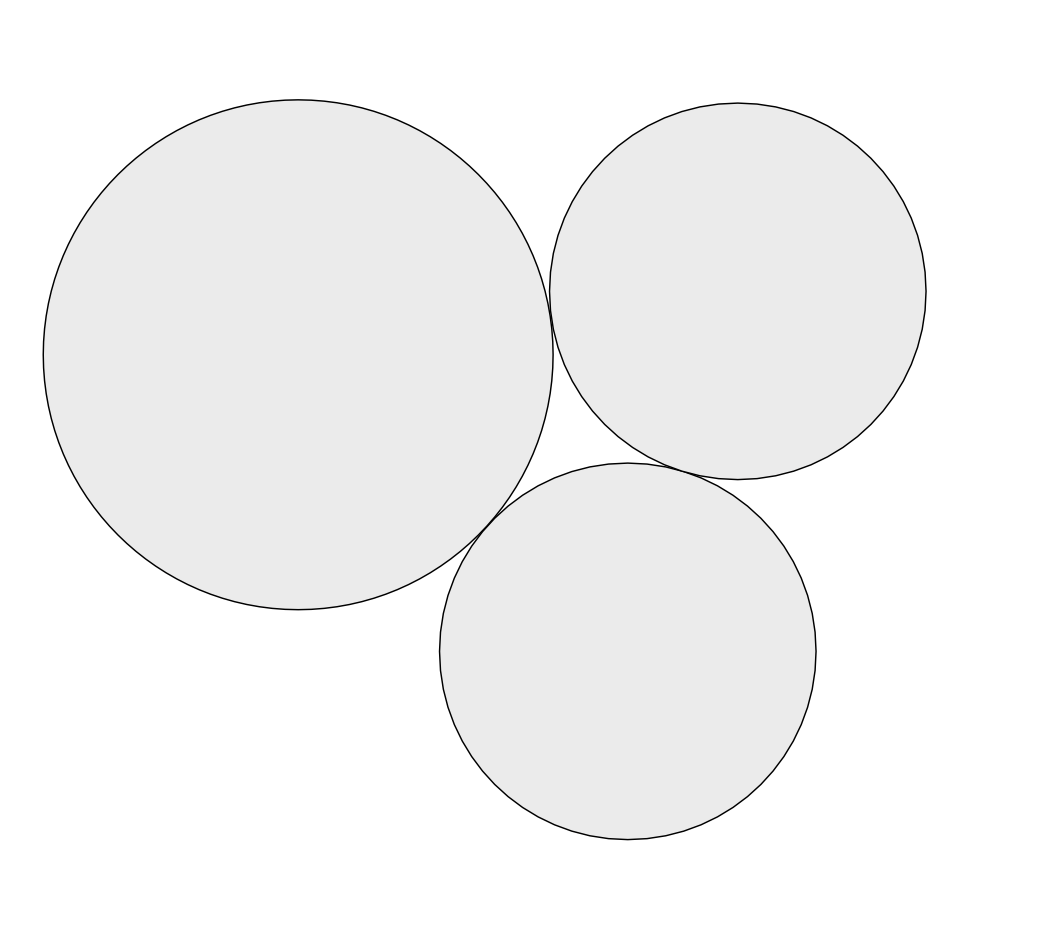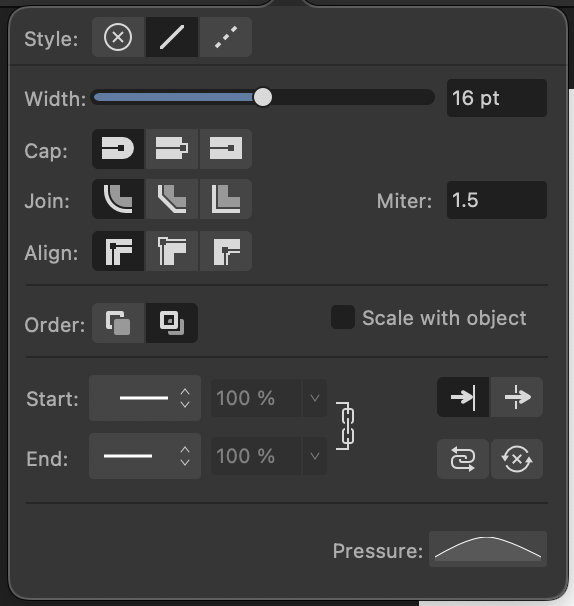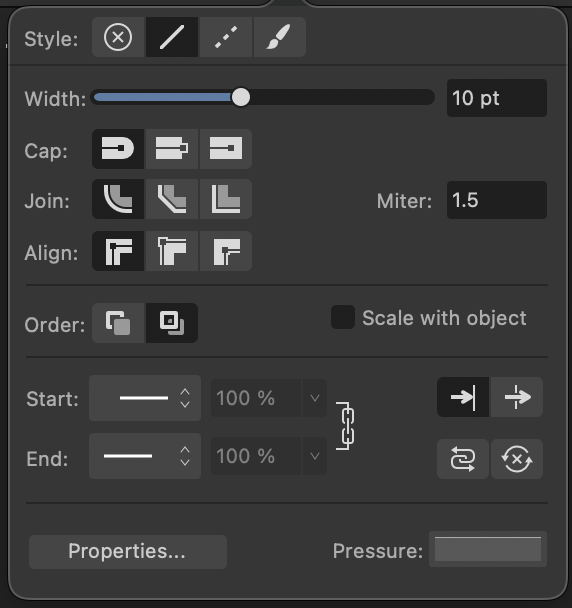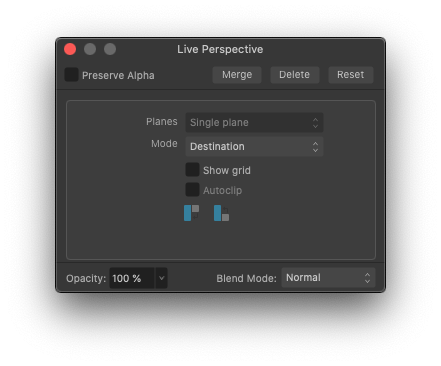
Mark Oehlschlager
-
Posts
634 -
Joined
-
Last visited
Posts posted by Mark Oehlschlager
-
-
That's the best manual work-around solution I've seen. Thanks.
Meanwhile, we need to bump the request for a new feature in Publisher that allows long tables to be threaded across multiple pages.
-
I'm here to request the ability to butt circles and other shapes up against one another with perfect snap alignment.
Whereas one can make use of geometry snapping to snap the anchor point of a curve to the circumference of a circle, one cannot (as far as I know) snap the circumference of one circle up against that of another circle.
How might one snap three circles together like those pictured below? Perfect tangential alignment.
-
It's close, but still produces small gaps for me. And then how does one achieve something like the arrangement below?
With anchor points, one can activate snapping to object geometry. But is there not something similar for butting shapes up against one another?
-
I'm wanting to perfectly align three circles with each other (no gaps or overlaps). Is there a way to get two or more circles to align at tangent points anywhere along the arc/circumference?
-
I've just attempted to use the Move Data Entry feature, asking a source object with an 8pt stroke to duplicate 5x to the left while scaling down at 80% with each step. I notice that while the object shape scales down, the stroke does not. (Strokes are set to scale with Object in the Transform panel.)
Is this a bug?
-
To follow up, attached below are the Stroke panels from Designer, Photo, and Publisher.
Photo's Stroke panel differs from Designer's Stroke panel by eliminating the "Textured Line Style" button at the top, and by eliminating the Properties button at the bottom. It makes sense. In Photo, raster brushes are segregated from simple vector strokes for curves and shapes. Because of this, simple Solid and Dashed Line Styles are not converted to brushes as they are in Designer, and the Pressure Curve applies correctly.
Publisher's Stroke panel lacks the "Texture Line Style" button seen in the Stroke panel for Designer, but it share's Designer's Properties button, which presents the same problem as seen in Designer: that simple "Solid Line Styles" get converted to "Textured Line Style" Vector Brushes if one should adjust the parameters of the Properties window.
Designer's Stroke panel has both the "Texture Line Style" button and the Properties button, which convert simple "Solid Line Style" strokes to Vector Brushes if one should adjust the parameters of the Properties window, or apply one of the Vector Brushes .
Proposed Solution: I feel there is a UI bug here to be corrected: there should be a simple way to convert a "Textured Line Style" Vector Brush (as applied to a curve or shape) back to a simple "Solid Line Style" stroke, responsive to Pressure Curves. That fix could be as simple as programming the "Solid Line Style" button to clear any Vector Brush "Textured Line Style" before re-applying a simple "Solid Line Style".
Photo Stroke Panel (Above)
Publisher Stroke Panel (Above)
Designer Stroke Panel (Above)
-
Hi @walt.farrell. Thanks for the reply.
Here are my observations:
- Once you open Properties and make a change to Brush Width, Size Variance, or Opacity Variance, you have permanently converted a simple stroke into some kind of Texture Brush controlled by the parameters of the Brush Options window.
- Once you apply a Vector Brush to a curve, it will forever remain a "Texture Line Style". There is no simple way (short of recreating the curve) to be able to get back to a simple "Solid Line Style" that is responsive to the Pressure Curve.
This seems like an interface bug to me.
-
I'm having trouble controlling the appearance of strokes from the Stroke panel. (I'm working with Designer 2.3.1 on an M3 iMac.)
- What exactly it the function of the Properties button in the Stroke panel?
- Why does a change to the Brush Options called up by the Properties button convert a "Solid Line Style" into a "Texture Line Style"?
- Why can one not convert a "Texture Line Style" from the Brushes panel back to a simple "Solid Line Style"?
- Are there Bugs here?
-
I begin with a Solid Line Style. If I draw an open curve with the Pen or Pencil tool, by default I get a solid line style with an assigned line width (e.g., 8 pt). No problem.
- I can taper the ends of the curve by editing the Pressure Curve in the Stroke panel. No problem.
- I can then use the width slider in the Stroke panel to increase the stroke width (e.g., to 12 pt), and the tapered ends from the Pressure Curve still apply. No Problem.
-
Odd things happen when I click the Properties button at the bottom of the Stroke panel, I get the Brush Options window where the Brush Width slider value does not correspond to the value of the Width slider at the top of the Stroke panel (e.g., 50 px vs. 12 pt). Is this a Bug/Problem?
- If I then adjust the Brush Width slider in the Brush Options window (e.g., from 50 px to 30 px), the taper effect of the Pressure Curve vanishes. It only returns if I now increase the Size Variance slider in the Brush Options window from 0% to 100%. Is this a Bug/Problem?
- Also, I notice that if I change the default value of the Brush Width slider in the Brush Options window, the Line Style option button at the top of the Stroke panel switches from "Solid Line Style" to "Texture Line Style". Is this normal?
-
If I begin with an 8 pt curve and then apply a Vector Brush from the Brushes Panel, I have a different experience.
- The value of the Width slider in the Stroke panel immediately changes to a larger value, and the Pressure Curve seems to apply to whatever Size Variance and Opacity Variance values are recorded with the specific Vector Brush. Is that normal?
- If I then select the "Solid Line Style" option at the top of the Stroke panel, I'm surprised to find that the curve does not lose the textured image of the Vector Brush. It seems that once a Vector Brush is applied to a curve, there is no way to convert the line style back to a simple black stroke of, say, 8 pts. Is this a Bug/Problem?
- How does one replace a Vector Brush with a simple solid Stroke?
-
@Rodi If one is doing layout for a document intended to go to press, printed by an offset press, one would set up the document from the beginning as a CMYK document. And in that case, by default, any type that one sets will adopt a process black color.
As for images/artwork to be placed into the layout of the CMYK document, you have options in development: a) for a pure CMYK workflow (press only) you could elect to build your images in CMYK; b) for a hybrid workflow (output to video, web, and press) you should build your images in a larger RGB color space, and then export final versions for the appropriate output color space.
-
@Lolalam Regarding your workflow, I would recommend a simple strategy:
Build / develop your images in the standard sRGB color space. From there, you can export to the same sRGB color space for web images, or to CMYK using the U.S. Web Coated SWOP v2 color profile. That should be your default.
If you want finer control, and you have a close working relationship with a printer, you might inquire whether or not that printer has specific recommendations for exported files.
-
On 3/2/2023 at 8:29 PM, Lolalam said:
2. i also am confused between RGB/8, RGB/16, I think there's even an RGB/24? then there's CMYK/8. What are their differences and similarities?
@Lolalam The numbers there indicate bit depth per color channel (i.e., how finely subdivided the range of values is for each color channel).
RGB/8 indicates that the dynamic range of color in your document it limited to 8 bits per color channel. In other words, for every pixel, the Red channel is capable of showing 256 levels of brightness. Same goes for the Green and Blue channels.
RGB/16 indicates that the dynamic range of color offers a more finely subdivided range of values, limited to 16 bits per color channel. Here, for every pixel, the Red channel is capable of showing 65,536 levels of brightness. Same goes for the Green and Blue channels.
Unless you are working on a high end display, and intend to display the final work on a high end display, it's not necessary to worry about these bit depths. Keep it simple: stick to RGB/8 and CMYK/8.
-
On 3/2/2023 at 8:29 PM, Lolalam said:
1. what is the difference and/or similarities between RGB and sRGB? i think i'm using rgb on my practice works but if i have a real client, i might have to switch or convert from rgb to srgb and vice versa.
@Lolalam RGB is simply an acronym for the additive color model wherein the colors of electronic displays (like you smart phone, desktop computer, or television) are described by mixtures of Red, Green, and Blue light contributions. Red + Green makes Yellow. Green + Blue makes Cyan. Blue + Red makes Magenta. The presence of Red, Green and Blue at full strength makes White. The total absence of Red, Green and Blue makes Black.
Not all electronic displays are capable of displaying the entire range (or gamut) of colors the human eye can perceive. Various electronic displays are capable of displaying a specific subset of the full range (or gamut) of visible color. Manufacturers measure and describe the range or gamut of color their displays are capable of reproducing, and the industry has developed names for these measurable color gamuts. These named color gamuts are also known as color spaces. sRGB is one such color space. sRGB does not offer the largest color gamut, but is considered to be the most common color space across the world of electronic displays. So, it's a standard RGB color space that most content creators target for images that need to be displayed as widely as possible.
Adobe RGB and ROMM RGB are much larger RGB color spaces. Some prefer to work in these larger color spaces at the beginning of their design/development workflows to preserve maximum color gamut before exporting out versions for print (CMYK) and web (sRGB), which are smaller color spaces.
When in doubt, keep things simple: build your images in sRGB. That way you're already in the correct color space for the web, and you can always export out a version for print in the smaller CMYK color space.
-
Ah. Yes. It makes sense that the auto-generated TOC paragraphs styles should not be duplicated – only modified.
But then the inability to specify a custom leader line character or pattern remains. Hopefully this comes to the attention of the Serif staff.
-
I've been working through Help files for Publisher 2.0.3, and have discovered a few problems:
- I'm unable to duplicate the auto-generated TOC Character and Paragraph styles. Is this by design?
- I'm unable to enter a custom character or character pattern for leader lines in the TOC Paragraph styles dialogue box. I'm limited to a period, underscore, or strikethrough.
-
- Add ability to group swatches into meaningful, user-defined groups within an Application/Document Palette (e.g. 'Primary', 'Secondary', 'Accents')
- Add ability to move swatches from one palette to another (as one can with brushes)
- Add ability to select multiple swatches via shift/command-click to move or delete those swatches in one move. (Presently, one can only delete swatches; and just one at a time.)
- Add ability to double click on a swatch to edit not only the color, but also it's 'global', 'overprint', and 'spot' attributes
- Change the default behavior when adding Pantone swatches to a palette such that the correct spot color name is applied rather than a generic name (i.e., "Pantone 105 CP" rather than "Global Color 13")
- Offer the user the option of directing an added Pantone swatch to a specific existing palette rather than creating a new separate document palette by default
- Add a live edit interface for designing custom color chords (Applies to the Color Panel as well.)
-
-
It's my understanding that one cannot take advantage of "Family Sharing" for the Universal V2 license because the Mac App Store "Family Sharing" license does not apply to in-app purchases, and because the Affinity Universal V2 license is considered to be an in-app purchase if bought through the Mac App Store.
What that means is that family members would have to log-in to the Mac App Store on all devices using just one family member's Apple ID. Not ideal.
Can anyone from Serif or the forum here say definitively whether or not one can by a Universal V2 license directly from Serif, and then be able to install on devices for up to 3-6 family members?
If so, what's the proper sequence of events?
-
@GRH Because the father-in-law and his wife want to take advantage of the "Family Sharing" license and the auto updates offered via the Mac App Store.
-
I don't see the V2 Universal license as an option in the Mac App Store. Just license options for the individual apps.
If anyone has experience in purchasing V2 Universal via the Mac App Store, would you please advise me on how to go about that?
-
Helping my father-in-law with his desire to upgrade to V2 without losing V1. Is this possible?
He's currently running V1 on OS X High Sierra (not able to run V2), but want's to take advantage of the 40% discount by purchasing V2 Universal now in advance of his planned purchase of a new iMac in January.
He bought his V1 apps through the Mac App store.
If possible, how should he go about purchasing the V2 Universal license today through the Mac App Store without losing access to his V1 apps?
-
Why is it that for so many "New ..." commands (new category, new swatch, etc.) the Affinity apps don't automatically throw up a naming dialog box? Seems quite logical to give the user the opportunity to name the newly created item straight away, rather than forcing one to go back into the menu structure with 3-4 extra clicks.EDIT: Allow me to apologize and to withdraw this post. I was watching one of the V2 tutorial videos (probably produced when V2 was still in Beta), and an Asset category first had to be created before it could then be selected and named. It reminded me of a complaint I had with the V1 apps.
I should have checked this behavior in the release version of the V2 apps. As I now actively create new items in my copy of V2 apps, a naming dialog box does indeed now appear by default, with the notable exception of the command to create a Spare Channel in Photo 2.
Sorry for the inaccuracy of the post.
- mrqasq and NewInBoston
-
 1
1
-
 1
1
-
-
Within the Export Persona, for individual export slices, I assume that 1x, 2x, and 3x are scaling factors for the pixel dimensions of the art to be exported (i.e., that a 64x64 px image would go out as 64x64, 128x128, and 192x192. But I'm unfamiliar with the absolute units expressed below (see attached image).
Would someone please explain the meaning of those absolute unit abbreviations and what effect they have on size of the exported slices?
Thanks.
-
I believe it’s the document’s color space that determines what can be displayed in document, regardless of whether or not one uses a larger color model to define colors. CMYK < sRGB < Adobe RGB < ROMM RGB < Lab.
What seems to be missing from the color palette is a warning when one chooses a color outside the gamut of the document’s color space. Also a clear explanation of how and when to use the Lock.








OKlab - OKlch color space
in Feedback for the Affinity V2 Suite of Products
Posted
I just became aware of OKLab and OKlch. Apparently both are now incorporated into the latest CSS specs.
OKlch is rapidly gaining popularity as a color model. OKlch is essentially a variant of CIE Lab wherein the abstract color components "a-opponent" and "b-opponent" are replaced with the more human readable color components of chroma (saturation), and hue.
OKlch improves upon the HSL color model by normalizing lightness values for colors with the same saturation and hue values. (Using the standard HSL model, a yellow and purple color sharing the same lightness (e.g., 50%) and saturation (e.g., 100%) will nevertheless show an apparent difference in lightness; whereas, using the OKlch model, that yellow and purple will display the exact same apparent lightness.)
Anyway, I'm sure the developers at Serif understand this and are aware. I would simply like to request that OKLab and OKlch color models be added to the Affinity suite.